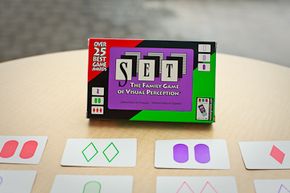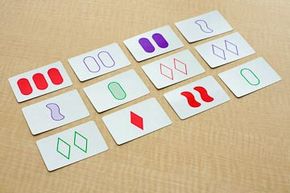SET® is a deceptively simple pattern-recognition card game with complex mathematical underpinnings. Each SET card has the following variations:
- Symbol: Oval, squiggle or diamond
- Color: Red, green or purple symbols
- Shade: Stripe, solid or outlined symbols
- Number: One, two or three symbols
The idea is to lay 12 cards face up, and then match three cards to make a SET. A SET includes three cards with common features: shape, color, shade or number of symbols. However, three completely different cards also can comprise a SET -- their common feature being that they have nothing in common. For example, if one card has a solid red oval, another card has two striped green diamonds and a third has three outlined purple squiggles, it is considered a SET. So for each variable, all the cards have to either be all the same or all different to make a SET. Just remember the "Magic Rule" from the game's makers: "If two are… and one is not, then it is not a SET" [source: SET Game].
Advertisement
SET was invented in 1974 when Marsha Jean Falco, a population geneticist, drew symbols on cards representing genetic combinations so that she could better visualize patterns in her data. The cards made Falco's research easier, but discovering all of the possible symbol combinations proved entertaining, too. Falco introduced the cards to her friends and family, who encouraged her to market it as a game. In 1990, SET went on sale at U.S. retailers and the game became a worldwide phenomenon, making this every man's chess a game for the ages [source: SET Game]. Hundreds of thousands of SET games have been sold since its debut. There are SET tournaments that draw dozens of players , ranging in age from 6 to senior citizen, and the New York Times publishes an online multiplayer version daily. You can play it on your smart phone or iPad, too.
At its core, the game of SET has a rich mathematical structure that follows set theory -- a type of mathematics that studies the behavior of and relationships between sets and has been around since the late 1800s [source: Math Now]. And playing SET teaches problem solving and observation in spades. The game has also been linked to theories about how problems can be simplified and solved in computer coding and geometry [source: Davis].
Although at first SET may seem difficult to understand, it's like most card games: Once you begin playing it, the rules make much more sense. Now that you have the basics, we'll share tips for mastering SET -- plus a 12-card puzzle -- on the next page.
Advertisement

